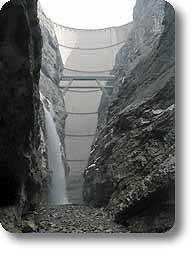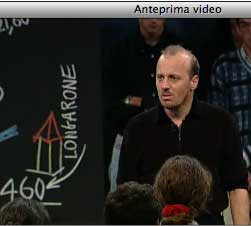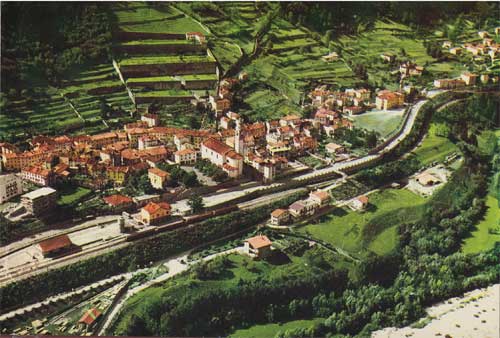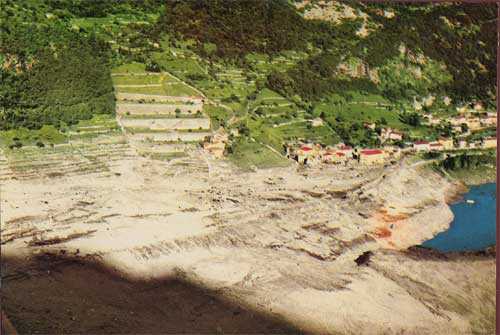|
|
|
|
|||||||||||||||||||||||
|
|
[ Back to INDEX "Almost a greek tragedy"This tale was exactly here: http://www.geocities.com/Athens/Acropolis/2907/vajont.html 
35 years later, the dam is still there. Nobody has been interested in preserving it, but the huge 261 mt concrete sail could resist well against time as it could stand the monumental failure of its left-flank wall. As someone said in those days, the Vajont dam was actually a masterpiece; but nobody thought that in the enthusiasm for the great challenge, a banal mistake was done: and to those engineers, managers, designers and politicians, seemed suddenly absurd that such a machine was condemned, before the very first test, to a complete and immediate death, because almost all of its left side could not stand the presence of an artificial lake.
Trees on the landslide mass were falling down, and terrain ruptures were evidently appearing while seismographic tracings revealed the upcoming catastrophe. Giancarlo Rittmeyer, who was in charge of the complex during the night on october the 9th, probably did not sleep at all. He was able to understand that something terrible could happen; but he didn't realize that what was going to happen was a sort of biblical disaster; and he probably did not realize completely that he would not see again the day. He warned Venice that the situation was turning to the worst, but he waited for a clearance before ask the police to evacuate people from the lower areas of Erto and Casso. So he kept thinking that a landslide would fall, but that it was not going to be what it really have been. Rittmeyer and his crew had an emergency shelter inside the rock-wall of Mount Toc close to the control building of the dam. But it did not save them: none of those in the control team SADE that night survived the disaster. Rittmeyer hoped it was not going to happen, really. And he didn't do what it could be an escape solution, like evacuating the structure with his men, going away after having directly ordered an emergency abandon-call by police in Erto, Casso and Longarone. Why? Because he hoped, till the end, that the damage was not going to be serious; that the landslide could have came down slowly, without killing anyone. And most of all, he had not the authority to order a massive evacuation, without clearance from his bosses. But if he had done it, it is probable that he would have been obeyed, and a few victims of Vajont could have been saved. Now, it is possible he even thought about that possibility: but how could he have done a so hazardous action, against all his superiors who had kept saying "Stay calm, don't worry?" For the informations they had given him, the landslide was not going to be catastrophic; there was a report saying that having the water level at 700 metres, "every possible landslide event" was not going to be harmful. If he had done something spectacular like ordering personally an emergency evacuation of the inhabitants in the area, and the landslide did not fall, what kind of destiny was he going to have, professionally speaking? Rittmeyer is just one – almost innocent- of the many actors in this modern tragedy. But in the story of Vajont, there are many of the elements of a classical greek tragedy: "Hybris": the arrogant strength to force elements in the way we want. "Peripetheia": the sudden change from an expected result, to an uncontrolled end. "Pathos": the sudden and terrifying destruction of wishes and expectations; something which brings a man from the idea of being a generous helper of mankind, to the knowledge of being the murder of two thousand innocents. 1. History of a disaster
At the beginning of the 20th century, production and management of electrical energy, in Italy, were developing slowly. After World War I, some private companies owned both production and supply facilities. 2. History of a mountain and a lakeOn february 3rd, 1961, in a geologic report, Prof. Leopold Müller communicated the results of his investigations about the Vajont. « In my opinion, no doubt can exist about this deep position of the landslide-bank (…). The landslide-volume should be calculated in about 200 millions cubed meters. (…) To the question if these motions can be artificially stopped, a negative answer is certain, generally speaking. Even if the facility function is stopped, such a huge landslide, after its first movement, will not come back soon to a complete stop. » The problem was turning into a serious danger. The fall of a large landslide was to be considered; but how "large"? And how was it going to fall? The geologists' opinions kept on being different. SADE would have not accepted easily the idea of a total failure; and choosed the less alarming responces. Müller, Semenza and Giudici had given a mass-calculation around 200 millions cubed meters; but other analysis were, as previously told, less alarming. Some calculations considered masses between 20 and 40 millions cubed meters. By these evaluations, the landslide was composed of 2 separate sections, which were going to fall one after the other. Moreover, despite to previous experiences, SADE did not believe that the theoretical fall was to be very fast; and the landslide mass, was also supposed to come down after a total rupture into very little elements. Working on these concepts, in summer 1961, SADE ordered a simulation-program to test the effects of a landslide from mount Toc. Simulations were performed during a year, by Prof. Augusto Ghetti, Padua University, in the "Centro Modelli Idraulici", SADE testing centre, at Nove di Fadalto. The model used during simulations was in 1:200 scale. In the meanwhile, at the Vajont facility, great works had been started, to reduce consequences of the possible accident. The water level was decreased to 600 mts; and a very large by-pass gallery was excavated in mount Salta (water intakes at 624 and 614 mts.). This device was conceived to allow the facility keeping on its functions in the possibility of a landslide dividing into two parts the artificial lake. On may the 10th, SADE requested clearence for an experimental level-increase up to 660 mts. The monitoring of the potential landslide was continuous. From august 1961 to september, 4 piezometers were installed inside the flank of mount Toc; and the deep composition of the rock was examined by tunnels. Despite to irregular motions of the landslide, just one of the four piezometers went out of order. In this case, there might have been movements among rock-strata; but the other three kept on work regularly, so that it could be evident, a very deep mass of rock was moving. At the end of october, the father of the Vajont dam, Civil Engineer Carlo Semenza, died. He was also the father of Edoardo Semenza, the geologist who had given a fathalistic memento, with Leopold Müller, to the destiny of the facility. To perform a better monitoring of the situation, SADE installed at the dam, by the control building, a very good seysmographic station; and superficial motions were observed optically using a system of lights positioned on geodetically relevant points. Nevertheless, the new Director of the facility, after Semenza's death, Engineer Alberico Biadene, decided not to communicate every possible information to governament. He started to delete, from official reports, some notes about seysmic activity connected to the artificial lake. On the other hand, as the water level increased, seysmic activities were increasing too. Temporary heartquakes were detected in the whole valley, more frequent and intense. But SADE kept on operating with no divulgation. On april the 20th, 1962, Giorgio Dal Piaz died too. He had been the main cooperator Semenza had had at the beginning of the project. And also; he was the last one geologist who could give a comprehensive view of what was going to happen. From that day on, SADE did not request any other official analysis by a geologist. On june the 8th, the official clearence to increase water level to 700 mts. was released by government. But on july the 3rd, as simulations on the model were finished, Prof. Augusto Ghetti wrote in his report: « The water-level at 700 mts can be considered perfectly safe in every possible landslide event. » Ghetti, however, made his evaluations considering a maximum landslide mass of 40 millions cubed meters. On the other hand, he warmly suggested to perform a new sequence of simulations, to investigate the possibility of a massive overflow beyond the dam. His suggestion was not accomplished. On november the 17th, 1962, the water-level at 700 mts was reached; the climb was stopped. Techical opinions about the situations were turning to the worst. The government adviser, Bertolissi, was communicating continuously his doubts. Geodetic observations detected motions in the landslide, which Bertolissi described as "coming to criticity". On december the 2nd, a slow water-level-decreasing was started. On march the 14th, 1963, facilities and functions of SADE were transferred, by Presidential Decree, to the new "Ente Nazionale per l'energia Elettrica" (=National Electric Energy Corporation), or "ENEL". In official documents, the Vajont facility was described as "Operational", but this condition could have been achieved just after the final test at level 715 mts. SADE had to complete its testings, before the complex burocratic procedures relative to the Vajont facility were finished; otherwise, the Vajont faciliy had to be sold as "Under Test" or even "Not Operational", and its price was going to be much lower, or null. On april the 10th, the partial water-discharge was stopped. At that moment, the level of the lake was 647.5 mts. The landslide was still giving important evidences of instability. Continuous, little heartquakes kept on being detected in the valley. Official protestations by people kept on arriving, and so did refutations by SADE. SADE wanted to show faur-play by the donation of a school, for those people who lived on Toc Mountain. The building had been already completed, but SADE had never given the clearence for its use, before. An elementary school was already at Casso; but those families who lived on the other side of the lake, says on Mount Toc, had to send their sons, everyday, for a very long walk around the lake. On the other hand, situation of Mount Toc was really dangerous. Walls coatings, in the houses, were coming down; rupture-lines were appearing inside the buildings; doors and windows started not to open or close well anymore. Wells and fountains started to be empty. The three surviving piezometres indicated that water inside the rock was at the same level that in the lake. This meant that the landslide mass was almost detached. On march the 20th, 1963, ENEL-SADE requested to increase water level up to 715 mts. Official clearence came 10 days later. The struggle between people in Erto-Casso and the ENEL-SADE reached its maximum. The mayor of the two towns, who had eliminated the prohibition, for persons, to go on the shores of the lake, after the donation of the new school, received an official reprimand by ENEL-SADE. The reason was the "permanece of the known danger". In the meanwhile, the road built by SADE all around the lake, was evidently uneven and going out of the original alignment. The school in Pineda, just one month after its first opening, was so damaged, that no further use was possible. On july the 22nd, the mayor of Erto and Casso sent a telegram to the Prefettura (=Police Regional Command) a Udine and to the ENEL at Venice. Seismic activity was still in progress, more and more aggressively. Next to the shore of the lake, on the other side of the valley, water was largely stained and turbid; while "continuous tremors and noises" were detected all around. On september the 1st, water reached level 709.40. At the dam, informations were serious. Biadene, who already had water 10 meters over the safety-level suggested by Ghetti, was soon going to complete his final test; but the landslide was too instable. It was not possible to keep on this way. The idea, at this point, was to stop lifting water. If they had mantained level 710 for a while, the landslide might have reached an equilibrium. The day after, a 10,30 AM, a strong heartquake. About grade 4 on Richter scale. Houses in the valley were suddenly shaken. On mount Salta a house came down in the center of the town. Beyond the dam there were 5 towns; over 2000 inhabitants. Worry turned into scare. On that day, the mayor of Erto, sent a letter to ENEL-SADE: « Others can minimize these things; (…) but for people in Erto these things regard life, safety and properties. This administration (…) request to your respectable corporation safety and certainty that the town is not going to live like in a nightmare. » No answer. At the dam, worry was almost panic. It was continuously repeated 'to keep cool'; but detections were alarming. On that day, september the 2nd. The whole grand landslide of mount Toc, perfectly compact and unique, had came, with the heartquake, 22 millimeters down. Then, it moved for 6.5 millimeters more during the day. Two days later, on september the 4th, as water reached level 710, the climb was stopped for good. Now they had to stop the landslide, someway. Discharging water fast, could have given the landslide the last, fathalistic, shock. The only reference they had was Ghetti's responce: "never overpass level 700 mts." And in those days they had 10 meters more. A shock-wave caused by the landslide could easily flow over the dam, which was just 11.60 mts higher, in those conditions. Town Erto, moreover, had some buildings below level 730, just 20 meters over water level. During the other testings, a tendency to equilibrium had been observed in the landslide, as the water level was stabilized. Perhaps, if this happened for some days, a subsequent slow level-decreasing, could bring to the safe level at 700 mts. Situation was critical; but on september the 12th, Biadene responded to the letter sent by the mayor of Erto. He used a dignified style: everything was perfectly under control. On september the 15th, the landslide came 12 millimeters down. Its speed was now two times faster. On september the 18th, at the dam, great technical meeting. Engineer Biadene, SADE representative and ENEL technical director; some ENEL-SADE technicians, and the building-operations Director at Vajont: Mario Pancini. Advisers Caloi and Oberti. The idea to reach level 715 was abandoned. If the situation was not going to get better, a decreasing of water level would have been a must. As the landslide was coming down, the risk of a catastrophic collapse was real; and there was still the problem to reach a safer level around 700 mts. On september the 26th, the landslide had came 22 millimeters more down. Biadene decided to discharge water, but this operation was started the day after. The water was to be eliminated, but at this stage it was very difficult to suggest how. Sending it away fast, could have determined the fall of the landslide; but also doing it slowly, could have determined the same result, as the landslide could absorb a higher quantity of water. Without suggestions about that (ENEL-SADE was still operating secretly), they choosed to discharge daily a quantity of water equivalent to 0,7 mts in the level of the lake. It was fast enough, and it corresponded to the maximum efficiency of the ENEL-SADE hydroelectric-production facility in Soverzene, started without government clearence, and alimented by Vajont. It is difficult not to think, that despite to the serious emergency, they were trying to have a profit. On the other hand, people were not warned about the increasing danger. ENEL-SADE was looking for a unofficial geologic reference; but they never found it. The Director of Vajont yard, Pancini, called on september the 30th ENEL-SADE central office, asking for the government geologic adviser Francesco Penta to come for a recognition. The situation was still, officialy, perfectly normal and under control. There was no official warning of the emergency. On october the 1st, Pancini left Vajont, for his planned holiday in America. He was officially substitued by Engineer Beniamino Caruso, SADE supervisor for hydroelectrical facilities in the area of "Medio Piave". Moreover, the already executive moving of Land-surveyor Giancarlo Rittmeyer, from Vajont to Venice was temporarily cancelled. Situation was really abnormal, and while Pancini was absent, an expert was supposed to stay there. On october the 2nd, the landslide came 40 millimeters down. Biadene went to Rome to discuss the matter with Engineer Baroncini, Central Director for ENEL-SADE hydraulic constructions. On that very day, Caruso, the provisional Director of Vajont yard, visited the dam and, as he realized the situation, he tried to call the government office in Belluno, but without any official indication of the problem. In the meanwhile, in Rome, they were trying to obtain a recognition by geologist Francesco Penta. On october the 3rd, the landslide came 40 millimeters down. Sunday, october the 6th. The fall of a large rock injuried a group of technical workers on mount Toc. Two of them are serious, the others are soon sent back to work. Monday, october the 7th. Caruso was again at the dam to monitor situation. Biadene was not there. The road again the lake was practically out of order. Geodetic-measurment-points were coming down with increasing speed: the landslide was moving for centimetres, everyday. In mount Toc, ruptures in the ground were appearing; noises and tremors were coming out from the terrain. Some trees were falling down. As night came down, inhabitants of Mount Toc received order to leave: just the three areas of Pineda, Liron and Prada were considered still visitable. The area in Pineda, particularly, despite to the whole situation, looked like being relatively stable, compared with the surroundings. Tuesday, october the 8th. Morning. At about 10,30, Biadene and Caruso were at the dam. Situation was very bad. After a couple of hours, Biadene sent a telegram to the mayor of Erto and Casso: « Increasing landslide motion area TOC left shore Vajont makes evacuation persons necessary. We warn (…) to operate urgently evacuation and declare forbidden permanence persons that area. Access to whole lake below level 730, and to road on left shore forbidden, from COSTA GERVASIO to PINEDA and dam. » If such a message was sent by ENEL-SADE, it was clear that situation was turning to the worst. On that same day, in both the towns was published this warning: « We advise population that ENEL-SADE technical offices detect instability in the flank of mount Toc, so that it is suggestable to leave the area from COSTA GERVASIO to PINEDA. It is recommended, particularly to people in Casso, to use the means made available by ENEL-SADE to take their leave from the area… and because of the fact that landslides from TOC can move frightening waves in the whole lake, we warn again the whole population that it is extremely dangerous to reach the shores of the lake; waves can reach a highness of many metres and kill even the very best swimmer. Who do not attend to these suggestions, exposes to the risk of death his life. » At about 3,30 PM, Bertolissi, the government adviser, was at the dam. He writes down a report that underlines the danger, and he asked Ministry for instructions. The report will be given to the local Director, Almo Violin, just the following morning; and it was sent to Rome in the afternoon, by normal postage. At about the same moment, Biadene called Rome, and he insisted with Baroncini to obtain a recognition by Penta (and/or, eventually by Government Testing Commission). Penta, who was insistently invited, accepted to send one of his assistants, Prof. Esu, to Vajont on friday, october the 11th. At evening, Police from Erto evacuates some areas below level 730. Wednesday, october the 9th, 1963 is a shining day. The sky is blue and nobody, neither in Longarone nor in the surroundings, feels what's going on at the dam. Somebody is waiting for the soccer match, that evening: Real Madrid versus Rangers Glasgow, a RAI 2 TV broadcast. Somebody, among the youths, preferres not to go to school, and goes trekking, in the beautiful morning. Up at the dam, feelings are dark. Biadene, in Venice, has his number 2 on holiday and he decides that it is necessary to call him back. He writes: « …In these past few days, translation speeds in the landslide have clearly increased (…). Ruptures in the terrain and in the road, the evident inclination of trees in the area over La Pozza; the enlargement of the grand rupture-line around the landslide, the motion of points near Pineda, which have been stable to this day, make me thinking of the worst. (…) Water level is going down, and this morning it should be at 700 mts. It is my intention to reach level 695 mts, to create a safety belt in the eventuality of waves. (…) I am sorry to send You so many bad news, and to force You to interrupt Your holiday. (…) May God help us. » It is a beautiful day, and the lake shines in its usual deep blue. Mountains, all around, show their quiet autumn colors. But the landslide is moving. The well-trained sensibility of workers, down at the dam, is less and less necessary, to detect motions in the mountain. At about twelve o'clock, some ENEL workers, having lunch on the top of the dam, see clearly the movement of Toc. A hour later, at about 1 PM, in the back of the "barracks", little buildings in the left shore of the lake, appears a rupture line 50 cmts wide and 5 mts long. It expands itself visibly. On the road around the lake, more and more ruptures appear. Between 3 and 4 PM, a worker who crosses an area of mount Toc, sees trees inclinating and falling. At 4 PM, the rupture near to the "barracks" is 1 mt wide. Before the evening, the whole landslide mass has came down 20 cmts. Its speed increases further. At about 5 PM, ENEL-SADE orders Caruso to call the police to suspend traffic in the area. At 5:50 PM phone-call between Biadene and geologist Penta, at Rome. Biadene confirms that the facility is decreasing water level, and that it is necessary to come below 700 mts. Penta suggests to avoid panic "before having good reasons". 6:00 PM. Biadene leaves the dam and goes back home in Venice. Rittmeyer and his crew stay to keep checking situation. As darkness come, photo-electric lights are lit at the dam, to ensure surveillance. A window, in the dam control building, has been dismantled, to allow an emergency escape of people inside. In the case of a huge landslide, technicians are expected to jump out of the building, run along a stepway and reach a sort of shelter inside the rock of the mountain. At 8:00, trucks involved in the last operations are no more able to move on the rupturing road. ENEL-SADE decides to close it. In the meanwhile, in a bar at Belluno, Caruso meets the local commander of police and asks insistently for an order to stop all traffic along the Alemagna road between towns Ponte nelle Alpi and Castellavazzo. The officer complies, and the traffic on that road is stopped: but no one warns people living in the area. There are 5 towns and more than 2000 inhabitants. At about 10:00, Rittmeyer calls Biadene; he is quite nervous. He warns that the mounting is starting to collapse, and he asks for instructions. Biadene tries to keep him cool; Rittmayer ask to evacuate people in Spesse village, which is at 729 meters (dangerous area) but it is the only one still inhabited. Biadene cleares him to order the evacuation. 10:39 PM. The landslide collapses, and falls suddenly. 260 millions cubed meters of compact rock rupture from mount Toc with a huge noise. The electroducts trough the valley are ripped away and produce, by short circuits, great lightnings that illuminate the whole valley. The priest in Casso, don Onorini, still working in his office, hears the noise and runs to a window oriented to the dam. He sees the whole flank of mount Toc, more than 100 mts high and almost 2000 wide, coming down towards the lake in the light-blue flashes. It is a giant "M", still having woods, houses and people on it, that runs at 100 km/h towards the lake. The interruption of electroducts makes light in almost all town Longarone, about 1.5 kilometers away. People have clearly heard the crack of the landslide; but they think it has been just a thunder. Those who come out of the bars, or who are in the streets, see perfectly flashes in the valley, but they think that just a huge thunderstorm is in progress on the top of the mountains. Some people are angry because of the loss of energy that have interrupted a pleasant evening.
The lake seems to disappear in a huge white cloud. It is actually a flying water-mass climbing up to 250 meters over its original level. It reaches level 950, very close to the town Casso. Rocks weighing thousands of pounds lift off just as sand grains. The right shore had a large rock rib, a sort of rampart, jutting out of the mountain, almost horizontally, around level 800. Seen today from a distance, it looks like a grand blade. It cuts the water-column, almost at its half height. In those very seconds, another wave, low and fast, is violently pushed to the east, in the opposite direction from the dam. Town Erto, at about level 730, is just skimmed; but its lowest houses are destroyed with their inhabitants. In the meanwhile, the high water-column reaches Casso. Terrain trembles, but most of its original strenght is lost. It can hit just the lowest buildings, without destroying them. The armoured-concrete elementary-school is invested. Windows brake into pieces; teachers sleeping at the second floor are suddenly woken up. Water climbs some metres more and reaches a three-floors house, hitting it on the side. The building stands the shock, but is damaged for good. Rocks are raining down from the sky, the wave flows to the west, and starts to fall downwards. The most of the water-mass falls beyond the dam. The road built on the top of the dam is ripped off and destroyed, falling, in pieces, into the valley on the other side. The control building of the dam is disintegrated and no trace of it stands the event. Any other surrounding structure is complitely dissolved. At Casso, in the meanwhile, rocks are still falling from the sky. One of them weighs more than 300 pounds. It brakes the roof of the church and it crashes inside. People, in the houses, survives perfectly the event, with no injury. The water mass that is now falling beyond the dam is about 50 millions cubed-metres. It falls vertically for 261 meters in a terribly narrow valley, so that pressure increases further the speed of water. As it comes out, it is 70 metres high, and about 100 km/h fast. In Longarone, nobody could still understand what's going on. The water-wall cannot be seen in the dark. At about 10:40, about 1 minute after the detachment of the landslide, in Longarone a soft wind starts to blow. It is the "underground-train effect". The arriving water-mass is expanding in width, and it pushes air straight ahead. The wind increases in strenght and people in the open-air start to feel a sudden increase in moisture. Somebody understands, and panic explodes. Wind becomes terrible. Doors and windows vibrate and sometimes are opened violently by the shock-wave. Terrain starts to vibrate strongly. Those who can get an idea of the situation, try to run away. Some of them run to their houses, to save their families. Some others try to get cars, bikes and motobikes. As the wave reaches the center of the valley, the bottom of river Piave, thousands of rocks are shot against the houses in Longarone. A thunder is heard, and tiles fly away from roofs. Some people, that do not know where to go, start instintively to run and climb the hillside in the opposite direction. The air, compressed by the water, becomes a shock-wave. It kills people and lifts things to great altitudes. Buildings are disintegrated as water arrives. Houses, churches. The large parrish-church of Longarone collapses completely; nothing survives, but three steps which led to the altar. Porticos, bars, houses, squares, roads, the railroads and station are practically erased away, and a unique mass of ruins and relicts is covered by water. People that survived the shock-wave are killed by stones, columns, entire walls. People running away along the State Road Alemagna are all killed. Those who were trying to climb the hillside are reached by the water-wave maybe around 10:43. The water has lost most of its original strenght, and it just pushes people upwards towards the top of the hillside. Then it stops and start flowing downwards again, so people are softly abandoned on the grass. The water has expanded; it goes back to the site of Longarone, while another part of the initial wave reaches and destroyes other many other buildings in Castellavazzo, Pirago, Rivalta, Villanova, Faè. River Piave increases its level for more than 12 meters. It will take many hours to get a normal level back.

|






